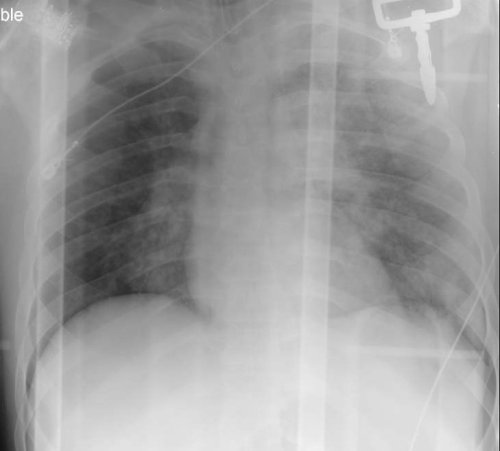Hemothorax and the Supine CXR
The initial imaging study of choice in most trauma patients is the supine CXR. However, supine CXR is notoriously bad in picking up hemothorax and pneumothorax (the sensitivity of supine CXR for pneumothorax…50%. That’s right, flip a coin [1]).
In an upright CXR, a hemothorax will layer out inferiorly, blunting your costophrenic angle and leaving what is often a dense layer. However, in the supine CXR, this is not the case.
The above CXR was taken from a trauma patient who sustained blunt injury after being involved in a motor vehicle crash. The CXR has a few interesting findings, including bilateral pulmonary contusion. Note, however, that the left lung appears hazy when compared to the right lung throughout. In a supine patient, blood will layer posteriorly and the ipsilateral hemidiaphragm will not be obscured. What you will see is what is noted above, the left lung appears generally more hazy compared to the right.
This brings up two learning points. First, remember that in a supine trauma patient, a hemothorax will not likely show up in the manner that you are used to. Look for haziness on one side compared to the other. I have even seen a resident think the more clear lung has a pneumothorax because it appears dark compared to the side with hemothorax. Second, remember that blood will go to the dependent portion of the thorax, which is why you want to make sure to direct your chest tube posteriorly if hemothorax is a concern.
And remember, a great way to detect hemothorax, even in the supine trauma patient, is to look above the diaphragm in the RUQ and LUQ on your FAST exam. US has been shown to be up to 96.2% sensitive and 100% specific in the detection of hemothorax [2].
1. Hesham RO, Hany A, Devanand M, et al. Occult pneumothorax, revisited. Journal of Trauma Management & Outcomes 2010, 4:12.
2. Ma OJ, Mateer JR. Trauma ultrasound examination versus chest radiography in the detection of hemothorax. Ann Emerg Med. 1997;29(3):312-316.
2 Notes
emrespodcast posted this


